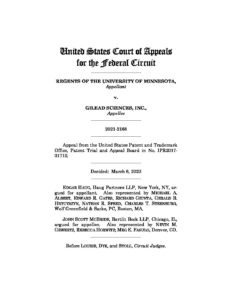By Jon Spenner
Reviewing an appeal from an inter partes review in Regents of the University of Minnesota v. Gilead Sciences, Inc., 61 F.4th 1350 (Fed. Cir. 2023), a panel of the U.S. Court of Appeals for the Federal Circuit affirmed the Patent Trial and Appeal Board of the U.S. Patent and Trademark Office in finding that the challenged claims lack written description in a priority application and are anticipated by an intervening reference.
U.S. Patent 8,815,830 (‘830 Patent to Minnesota is directed to phosphoramidate prodrugs of nucleoside derivatives for preventing viruses from reproducing or cancerous tumors from growing. The broadest of the challenged claims, claim 1, recites a genus by claiming a structure having several R group substituents, where the R groups each represent chemical moieties and with many of the R groups representing a genus of several chemical moieties. Encompassed by claim 1 is sofosbuvir, Gilead’s FDA-approved drug that treats chronic hepatitis C infections.
The ‘830 Patent issued from an application, filed in 2014, that claims priority to several earlier applications, the earliest being a provisional application filed in 2004. In addition, an unrelated Gilead patent application was published in 2010 that the parties agreed discloses every limitation of each challenged claim. Thus, the question was whether the challenged claims could claim priority to an application that predated the Gilead published application or otherwise be invalid due to the published application.
For satisfying the written description requirement, Minnesota did not argue that the priority applications described a sufficient number of species to constitute a written description of the claimed subject matter. Instead, they asserted that the provisional application literally described or provided blaze marks to the subject matter. Minnesota pointed to several claims in the provisional application and combined them in an attempt to arrive at the claimed genus. However, the Court found that their argument included optional choices that did not define the genus, stating that the claims of the provisional application recite “a compendium” of functional groups, yielding “a laundry list” of different moieties for every possible functional group.
The Court found that there was no literal support nor blaze marks to inform one of ordinary skill in the art that the claimed subject matter was described in any priority application that predates the Gilead published application. Therefore, the challenged claims were anticipated by the Gilead published application and were thus invalid.
Minnesota attempted to construct an application to encompass sofosbuvir, seemingly becoming aware of the drug long after Minnesota’s original provisional application was filed. However, this Federal Circuit decision makes clear that cherry-picking features from disparate claims or sections from an application, without more, will not satisfy the written description requirement. Possession of the claimed subject matter must have been understood by one of ordinary skill in the art, and the application at least needed to point one of ordinary skill in the direction of the claimed subject matter.


